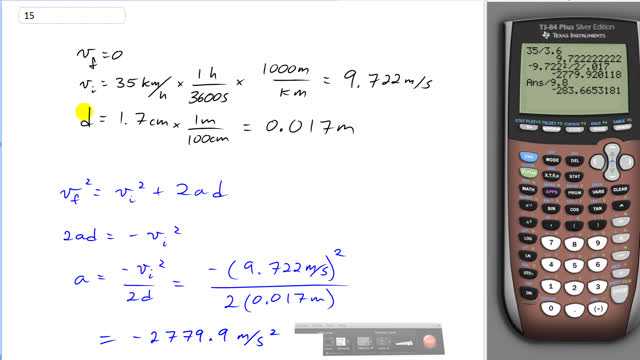
Can cars “stop on a dime”? Calculate the acceleration of a 1400-kg car if it can stop from 35 km/h on a dime (diameter = 1.7 cm). How many g’s is this? What is the force felt by the 68-kg occupant of the car?

In order to watch this solution you need to have a subscription.
This is Giancoli Answers with Mr. Dychko. We'll, setup the question by listing the stuff that we know and do any unit conversions that are necessary at the beginning so we can get it out of the way. The final speed of the car is zero because it comes to a stop, and its initial speed is 35 kilometers an hour, and we'll times by one hour for every 3600 seconds and then times by 1,000 meters for every kilometer to end up with m/s, and that's the same as dividing by 3.6 which is what I did in the calculator. And that gives 9.722 m/s. The distance over which the car is gonna stop is going to be a dime diameter, 1.7 centimeters. And we'll multiply by 1 meter for every 100 centimeters to get 0.017 meters. So, first we'll find the acceleration that the car would have, and final velocity is zero. Subtract Vi squared from both sides and then switch the sides around and divide by 2d to solve for a. And acceleration then is negative of 9.722 m/s squared divided by 2 times 0.017 meters, and that gives negative 2779.9 m/s squared. And the number of g's is calculated by taking that acceleration times one g for every 9.8 m/s squared, and these m/s squared as a package cancel here, this is one, the numerator, and this is 1 m/s squared in the denominator. So, they cancel leaving us with g's, that would be 280 g's which would be impossible to survive, 30 g's is about the maximum that someone can reasonably expect to survive. That's listed in, question six actually mentions that. So, good thing the cars can't stop in a dime because you, wouldn't be possible to survive it anyway. And the net force is going to be the mass of the passenger times its acceleration. So, that's 68 times negative 2779.9. The negative sign just means that the direction of this acceleration and the force are opposite to the initially positive velocity. So, two sig figs there. So, that's 1.9x10^5 Newtons. There we go.